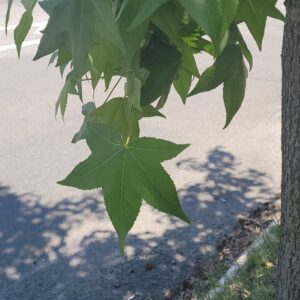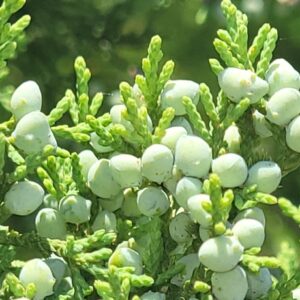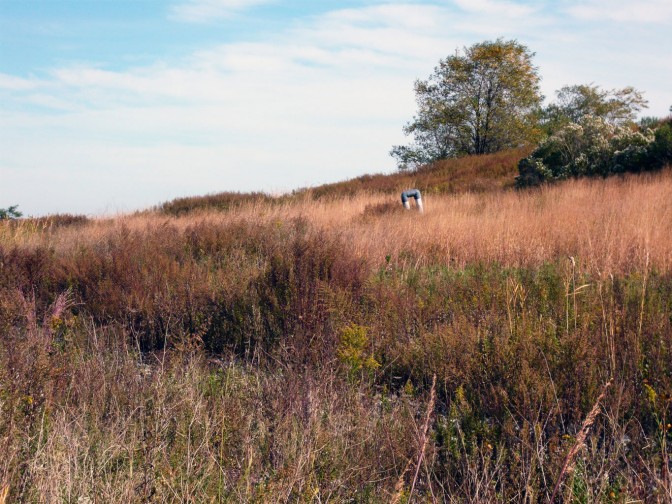iNaturalist Scavenger Hunt – Trees of the New Springville Greenway
 Lace up your shoes, download the free (and easy to use) iNaturalist app and head to the New Springville Greenway for a scavenger hunt. Along the path you’ll encounter a variety of trees, some native to the region and some less welcome pushy volunteers. To help you, we have provided a list of trees below that you are likely to encounter. When identifying a tree, there are several characteristics available to assist: the shape of the tree, growing conditions, color, and shape of the leaf, and even the wildlife supported. These characteristics can also be instructional when deciding what tree to plant in a greenspace. Knowing if a tree is invasive, going to grow too large, requires a lot of maintenance or attracts certain animals, may lead to more informed and beneficial tree planting decisions.
Lace up your shoes, download the free (and easy to use) iNaturalist app and head to the New Springville Greenway for a scavenger hunt. Along the path you’ll encounter a variety of trees, some native to the region and some less welcome pushy volunteers. To help you, we have provided a list of trees below that you are likely to encounter. When identifying a tree, there are several characteristics available to assist: the shape of the tree, growing conditions, color, and shape of the leaf, and even the wildlife supported. These characteristics can also be instructional when deciding what tree to plant in a greenspace. Knowing if a tree is invasive, going to grow too large, requires a lot of maintenance or attracts certain animals, may lead to more informed and beneficial tree planting decisions.
So, whether you ever asked yourself the name of a tree, or just recently became curious what makes up the urban forest, now is the time to explore and make some observations. Head out solo, or bring your friends and family, the more citizen scientists, the better. In addition, to an increased understanding of the wildlife around us, observations made in the iNaturalist app help support conservation efforts. While on your scavenger hunt, don’t waste those steps, and participate in the Fresh Fit Mall Mile initiative. Simply walk a mile on the greenway, submit proof here, and receive a complimentary gift for enjoying the outdoors from EmblemHealth (located just off the greenway, outside the SI Mall).
Happy hunting and please, remember to be mindful of others while using the path. How many trees did you find, did you find anything else that was interesting? Please share some of your pictures on social media using #FreshFitMallMile
American Sweetgum (liquidambar styraciflua) – Native to eastern United States
 Profile: At maturity can reach 60 to 70’ tall and spread 45’. Grows in a pyramidal shape and becomes more round with age.
Profile: At maturity can reach 60 to 70’ tall and spread 45’. Grows in a pyramidal shape and becomes more round with age.- Leaves: Star-shaped leaves with 5 lobes (points). They are medium green in the warmer months and become vibrant oranges, reds, and purples in the fall.
- Trunk Bark: The bark is light grey, with deep ridges. Underneath the bark is a gummy sap, with a sweet odor, that seeps out when the tree is wounded.
- Conditions: Found mostly on lowlands, needs full sun, has some drought tolerance, but cannot tolerate alkaline soil.
- Wildlife Supported: Produces woody burrs, approximately 1.5” in diameter, the seeds are food for small birds and mammals. Luna moths use this tree as a larval host plant.
Pin Oak (quercus palustris) – Native to eastern and central United States
 Profile: At maturity can reach 60 to 70’ and spread 25 to 45’; the tree grows in a pyramidal shape.
Profile: At maturity can reach 60 to 70’ and spread 25 to 45’; the tree grows in a pyramidal shape.- Leaves: Dark green leaves are long with 5-7 lobes, with deep sinuses (indents between lobes) and relatively smooth. The leaves turn deep red and bronze in the Fall.
- Trunk Bark: Younger trees have smooth red-gray bark that becomes grayer and rougher as the tree matures.
- Conditions: Common in landscaping due to ease of transplant; this tree is pollution and moist soil tolerant.
- Wildlife Supported: Produces acorns, which are nearly round and about ½” wide, provides food for a number of songbirds, small mammals, and especially ducks.
Eastern Red Cedar (juniperus virginiana) – Native to eastern North America
 Profile: At maturity can reach 40 to 50’ tall and spread 8 to 20’; the tree has a dense pyramid shape.
Profile: At maturity can reach 40 to 50’ tall and spread 8 to 20’; the tree has a dense pyramid shape.- Leaves: Tree is coniferous. Early juvenile leaves are sharp and needle-like, adult leaves are tight and scalelike, in intersecting pairs.
- Trunk Bark: The bark is reddish- brown, fibrous, and narrow strips peel easily. Where exposed, the under bark is ashy gray.
- Conditions: Considered a pioneer species, meaning it can be the first tree to repopulate damaged, cleared, or eroded land.
- Wildlife Supported: Trees are usually dioecious, which means they produce either male pollen or female seed cones. Occasionally some trees are monoecious and produce both pollen and cones. Seed cones are wax coated, purple-blueish, and berry-like, and are an essential source of food for wintering birds. This tree also provides nesting locations for small birds.
Staghorn Sumac (rhus typhina) – Native to eastern North America
 Profile: At maturity can reach 15 to 30’ tall and spread 20 to 30’; usually treelike in shape but can grow shrubby when in thickets.
Profile: At maturity can reach 15 to 30’ tall and spread 20 to 30’; usually treelike in shape but can grow shrubby when in thickets.- Leaves: Has alternate, pinnately green compound leaves, with 9- 12 serrate leaflets, which turn bright red, orange, and yellow in the fall.
- Trunk Bark: The bark is brownish-gray. The bark of young trees is hairy, but become smoother, and eventually scaly as the tree matures.
- Conditions: Can tolerate adverse conditions, most often found in dry and poor- quality soil.
- Wildlife Supported: These trees produce pyramidal red flowers from May to July, and the fruit ripens from June to September. The berries are a source of food for wintering birds.
Eastern White Pine (pinus strobus) – Native to northeast North America
 Profile: At maturity can reach 50 to 80’ tall in cultivated landscapes, and up to 135’ in the wild, and spread 20 to 40’, in an oval, pyramidal shape.
Profile: At maturity can reach 50 to 80’ tall in cultivated landscapes, and up to 135’ in the wild, and spread 20 to 40’, in an oval, pyramidal shape.- Leaves: Tree is coniferous, with long, flexible, needle-like blueish-green leaves in fascicles (groups) of 5, sometimes less. The sheath at the base of the needles is deciduous, which falls off during their first growing cycle. This is the only native soft pine in the Northeast, hard pines in the area have a permanent sheath on the fascicles.
- Tree Bark: The bark of young trees is smooth and greenish gray. As the tree matures, the bark becomes grayish to reddish brown with ridges.
- Conditions: Prefers well drained or sandy soils in humid climates but can adapt to boggy areas or rocky highlands. They do not tolerate pollution.
- Wildlife Supported: The bark, buds, foliage, and cones of the Eastern White Pine feed several insects, birds, and mammals. In addition, these trees provide nesting sites for a variety of birds from cooper’s hawks to warblers.
Willow Oak (Quercus phellos) – Native to eastern and central United States
 Profile: At maturity, tree reaches 40 to 60’ tall with a spread of 35’ wide. Young plants are pyramidal, and the tree becomes more oblong-oval and rounded as it reaches maturity.
Profile: At maturity, tree reaches 40 to 60’ tall with a spread of 35’ wide. Young plants are pyramidal, and the tree becomes more oblong-oval and rounded as it reaches maturity.- Leaves: Leaves are spear-shaped and start as light green in the spring, becoming brighter in summer; in fall the leaves turn yellow and yellow brown.
- Trunk Bark: The bark of young trees is smooth and reddish-brown and turns to gray- brown with shallow grooves and ridges as it matures.
- Conditions: Prefers full sun light and loamy well-draining soils but can tolerate poorly drained soil. Often found growing on lowlands, near streams.
- Wildlife Supported: Produces acorns about ½” long with a thin saucer cap, the acorns are the preferred food for whitetail deer, small mammals and some songbirds.
Black locust (robinia pseudoacacia) – Native to southeastern United States – Invasive in New York
 Profile: At maturity grows 30 to 50 ft’ tall and spreads 20 to 35’ wide; grows in an oval shape.
Profile: At maturity grows 30 to 50 ft’ tall and spreads 20 to 35’ wide; grows in an oval shape.- Leaves: Each leaf contains 3-9 opposing leaflets, and one terminal leaflet. Leaflets are small or elliptical. The leaves turn an uneventful yellow in the fall.
- Trunk Bark: The bark color can vary from dark reddish brown, to black, to gray. In addition, it has many grooves and divots, that intersect and criss-cross, often creating diamond-like shapes.
- Conditions: Needs open space and full sun to become established. Can tolerate most soils, but prefers basic and moist, well-drained soil.
- Wildlife supported: The flowers produce a choice source of pollen for bees, and the pea pod like fruit contains seeds, which are enjoyed by whitetail deer and squirrels. Like other legumes, the roots fix nitrogen from the air making it available in the soil for other plants. However, outside its native range, this species is considered invasive because it spreads easily by outcompeting other sun loving plants
White Poplar (populus alba) Native to Europe & Asia – Invasive in New York
 Profile: At maturity, tree can be 40 to 70’ tall and spread 40 to 70’ wide; it grows in a round shape.
Profile: At maturity, tree can be 40 to 70’ tall and spread 40 to 70’ wide; it grows in a round shape.- Leaves: Has distinctive 5 lobed leaves, almost star shaped, which have a dark green surface and a white underside that turns yellow in the fall.
- Trunk Bark: The bark is white and stays smooth until it is very old, when the bark can become rigid.
- Conditions: Prefers full sun, open sites, and moist soil along waterways.
- Wildlife supported: The flowers, called catkins, while pollinated by the wind, are an early source of pollen for pollinators and the seeds are eaten by local birds. Spreading by root suckers, these trees outcompete other plants for sun and nutrients and are considered invasive in New York.
White Mulberries (morus alba) – Native to China – Invasive in New York
 Profile: At maturity, trees can reach 40 to 60’ tall and 40’ wide. This tree grows in a variety of shapes, from saggy and droopy to pyramidal.
Profile: At maturity, trees can reach 40 to 60’ tall and 40’ wide. This tree grows in a variety of shapes, from saggy and droopy to pyramidal.- Leaves: Leaves are generally, tear drop shaped, and attached in an alternating pattern to the twig, tops are dark green and glossy, and undersides are lighter green and dull, and the leaf margins are coarsely serrated. In the fall, leaves turn yellow and drop quickly.
- Trunk Bark: The bark is usually grayish brown with flattened ridges, and shallow vertical grooves. As the tree matures, the bark becomes grayer, and grooves become deeper and curved.
- Conditions: Prefers full sun and is not particular about soil quality, can grow in loamy, clay, or sandy soil.
- Wildlife Supported: Native to China and the primary source for silkworms, this species is invasive in New York and is a threat to the native Red Mulberry (morus rubra), A white mulberry tree can transmit a root disease to their native counterparts and ultimately displace Red Mulberry trees from their usual territory.




